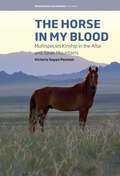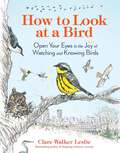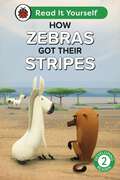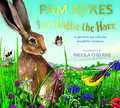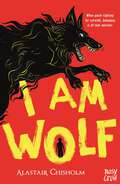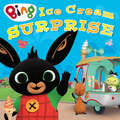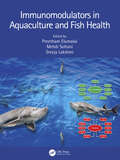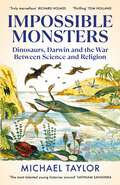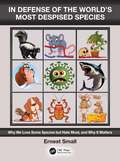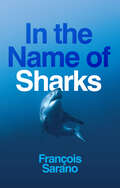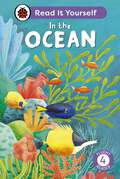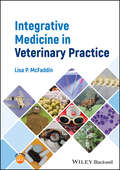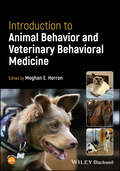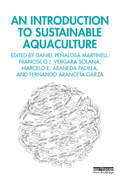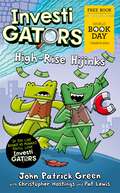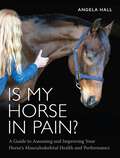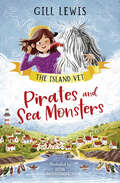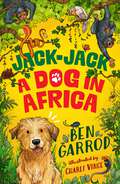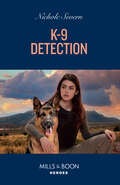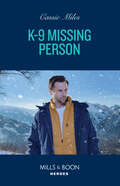- Table View
- List View
The Horse in My Blood: Multispecies Kinship in the Altai and Saian Mountains (Interspecies Encounters #4)
by Victoria Soyan PeemotA fascinating interspecies relationship can be seen among the horse breeding pastoralists in the Altai and Saian Mountains of Inner Asia. Victoria Soyan Peemot herself grew up in a community with close human-horse relationships and uses her knowledge of the local language and horsemanship practices. Building upon Indigenous research epistemologies, she engages with the study of how the human-horse relationships interact with each other, experience injustices and develop resilience strategies as multispecies unions.
How to Look at a Bird: Open Your Eyes to the Joy of Watching and Knowing Birds
by Clare Walker LeslieBestselling author and acclaimed nature illustrator Clare Walker Leslie invites beginning birdwatchers to hone their observational skills with this easy-to-use visual guide. Using her signature nature journal illustrations, Leslie shows readers the key clues to look for, from the shape of the beak or talons to distinctive feather colorings, flight patterns, and behavioral traits. She offers simple prompts that encourage readers to embrace curiosity and take a closer look: Where are you? What season is it? How is that bird moving or eating? With an emphasis on the birds that are most likely to be seen at a feeder, in a city park, or at a nature preserve, How to Look at a Bird makes bird watching, identification, and appreciation accessible to everyone, no matter where they live. This publication conforms to the EPUB Accessibility specification at WCAG 2.0 Level AA.
How Zebras Got Their Stripes: Read It Yourself - Level 2 Developing Reader (Read It Yourself)
by LadybirdBased on the classic West African folktale about bravery. Why are zebras stripy, and why do baboons have red bottoms? Find out what happens when a bossy baboon and a plucky little zebra go head-to-head, with long-lasting consequences.How Zebras Got Their Stripes is from Developing Reader Level 2 and is ideal for readers aged from 5+ who can read short, simple sentences with help.Each book has been carefully checked by educational and subject consultants and includes comprehension puzzles, book band information, and tips for helping children with their reading.With five levels to take children from first phonics to fluent reading and a wide range of different stories and topics for every interest, Read It Yourself helps children build their confidence and begin reading for pleasure.
I am Hattie the Hare: A tale from our wild and wonderful meadows
by Pam AyresJoin Hattie the playful Brown Hare as she leaps from meadow to farm to heath, in this heartwarming tale written in rhyme by the much-loved poet Pam Ayres, author of The Last Hedgehog.We didn’t always live here, once we had a sunny home,We came here with centurions, all the way from Rome . . .From grape green meadows to old-fashioned farms, hares travelled thousands of miles to find a home in the British countryside. What do they eat? What's their perfect habitat? Can you tell them apart from rabbits?Wonderfully illustrated by award-winning artist Nicola O'Byrne, I Am Hattie the Hare is a follow-up to the bestselling I Am Oliver the Otter. Bursting with natural and historical facts interwoven throughout the story, and with an information spread at the end that includes tips on where to spot these gentle animals.
I Am Wolf (I Am Wolf)
by Alastair ChisholmAn outstanding, highly original and unputdownable read! This is a bold, thought-provoking adventure perfect for fans of MORTAL ENGINES and THE LAST WILD. "I loved every page of this gripping, dystopian thriller. Wonderful characters, thrilling action and a unique new world. Now I wish I had my own animal construct!" Kieran Larwood, author of Podkin One Ear "I wolfed this down... Great MG sci-fi." Darren Simpson, author of Scavengers Coll belongs to Wolf. He lives with his crew on a Construct, a huge technological "creature" driven by the crew's combined willpower. Together they roam their world, fighting other Constructs and absorbing them into their own. But when a new and dangerous Construct attacks them, Coll is thrown clear from Wolf and left behind. Now he must survive life on ground and get back to his crew. He is helped by Rieka, a "Tock" who makes the Constructs work. She promises Coll a way to return, but can she be trusted? And what is she really trying to do...? When Coll uncovers the truth, it destroys everything he thought he knew about Wolf, the world they live in, and even himself. In a world full of danger, and suddenly without meaning, can he find a way back?
Ice Cream Surprise (Bing)
by HarperCollins Children’s BooksA wonderful new picture book story about something all kids do at one point or another – dropping their ice cream – based on the award-winning CBeebies preschool show Bing! It’s a hot day and Bing really wants an ice cream. But first he needs to find Gilly’s ice cream van. Bing and Flop race all over the park to find her, only for Bing to then drop his ice cream while waving goodbye as the van pulls away. Poor Bing! A very relatable story that helps kids talk about things that upset them, manage their disappointment and eventually feel better.
Immunomodulators in Aquaculture and Fish Health
This reference book provides updated information about different immunomodulators for managing fish health and sustainable aquaculture. Immunomodulators are dietary additives that enhance innate defense mechanisms and increase resistance against specific pathogens and diseases. The book covers the different types of immunostimulants, their modes of action, and their efficacies. It also reviews safety concerns, ethical regulations, limitations, and outreach to farmers. It discusses the application of herbal immunomodulators, antioxidants, pre- and pro-biotics, in disease management. Features:• Reviews the pressing topic of reduction of antibiotic use in aquaculture • Discusses herbal immunomodulators, nutrients, antioxidants and pre- and pro-biotics • Covers the topic of progressive immunomodulation using nanotechnology • Discusses fish health management in the ever-growing aquaculture industry • Includes natural and synthetic immunomodulators The book is meant for researchers and industry experts in aquaculture, fisheries science, and veterinary medicine.
Immunomodulators in Aquaculture and Fish Health
by Preetham Elumalai Mehdi Soltani Sreeja LakshmiThis reference book provides updated information about different immunomodulators for managing fish health and sustainable aquaculture. Immunomodulators are dietary additives that enhance innate defense mechanisms and increase resistance against specific pathogens and diseases. The book covers the different types of immunostimulants, their modes of action, and their efficacies. It also reviews safety concerns, ethical regulations, limitations, and outreach to farmers. It discusses the application of herbal immunomodulators, antioxidants, pre- and pro-biotics, in disease management. Features:• Reviews the pressing topic of reduction of antibiotic use in aquaculture • Discusses herbal immunomodulators, nutrients, antioxidants and pre- and pro-biotics • Covers the topic of progressive immunomodulation using nanotechnology • Discusses fish health management in the ever-growing aquaculture industry • Includes natural and synthetic immunomodulators The book is meant for researchers and industry experts in aquaculture, fisheries science, and veterinary medicine.
Impossible Monsters: Dinosaurs, Darwin and the War Between Science and Religion
by Michael TaylorImpossible Monsters is the captivating story of the discovery of the dinosaurs and how it upended our understanding of the origins of the world.‘An astonishing book about an extraordinary subject' PETER FRANKOPAN'As thrilling as it is sweeping' TOM HOLLAND‘The most talented young historian around ... A triumph’ SATHNAM SANGHERAIn 1811, a twelve-year-old girl uncovered some strange-looking bones in Britain’s southern shoreline. They belonged to no known creature and were buried beneath a hundred feet of rock. Over the next two decades, as several more of these ‘impossible monsters’ emerged from the soil, the leading scientists of the day were forced to confront a profoundly disturbing possibility: the Bible, as a historical account of the Earth's origins, was wildly wrong.This is the dramatic story of the crisis that engulfed science and religion when we discovered the dinosaurs. It takes us into the lives and minds of the extraordinary men and women who made these heretical discoveries, those who resisted them, as well as the pioneering thinkers, Darwin most famous among them, who took great risks to construct a new account of the earth’s and mankind’s origins.Impossible Monsters is the riveting story of a group of people who not only thought impossible things but showed them to be true. In the process they overturned the literal reading of the Bible, liberated science from the authority of religion and ushered in the secular age.‘Truly marvellous ... an intellectual thriller’ RICHARD HOLMES‘A stunning work ... of surprises and revelations’ STEVE BRUSATTE
In Defense of the World’s Most Despised Species: Why we love some species but hate most, and why it matters
by Ernest SmallSome animals and plants injure or kill millions of people annually, others cause trillions of dollars in property damage and loss. Such harmful species are understandably hated. However, the vast majority of the planet’s millions of species are disliked simply because of how they look and act. This bias is endangering numerous species that play important roles in maintaining both the natural ecosystems and the human economies of the world. In Defense of the World’s Most Despised Species examines the psychological motivations that lead people to make judgments about the attractiveness of species, noting the overwhelming importance of visual cues. It describes in considerable detail the physical and behavioral traits of species that lead us to love or hate them. Full color illustrations throughout present beautiful, charming animals and plants, species that seem loathsome, behavior of people in relation to such divergent species and their characteristics, and numerous explanatory diagrams of relevant biological and psychological phenomena. The aim of this book is to give readers insights into how we humans arrive at biased judgments and to promote the welfare of valuable, albeit sometimes unlovable animals and plants that consequently suffer from discrimination. Many of the ugliest, most disgusting, and feared species, such as vultures, toads, hyenas, sharks, spiders, and even the vast majority of cockroaches, in reality are some of our most valuable friends. Features Theme of the book – human preferences for and against species – is novel, scarcely examined to date. Multidisciplinary analysis, especially psychology, biological conservation science, and ecology, as well as philosophy, agriculture, urban planning, human health, and law. Text is accessible, user-friendly, concise, and well-organized, making numerous complex topics comprehensible, readable not only by specialists, but also by students and the educated layperson. Includes over 2,000 high-quality, entertaining, and informative color figures.
In Defense of the World’s Most Despised Species: Why we love some species but hate most, and why it matters
by Ernest SmallSome animals and plants injure or kill millions of people annually, others cause trillions of dollars in property damage and loss. Such harmful species are understandably hated. However, the vast majority of the planet’s millions of species are disliked simply because of how they look and act. This bias is endangering numerous species that play important roles in maintaining both the natural ecosystems and the human economies of the world. In Defense of the World’s Most Despised Species examines the psychological motivations that lead people to make judgments about the attractiveness of species, noting the overwhelming importance of visual cues. It describes in considerable detail the physical and behavioral traits of species that lead us to love or hate them. Full color illustrations throughout present beautiful, charming animals and plants, species that seem loathsome, behavior of people in relation to such divergent species and their characteristics, and numerous explanatory diagrams of relevant biological and psychological phenomena. The aim of this book is to give readers insights into how we humans arrive at biased judgments and to promote the welfare of valuable, albeit sometimes unlovable animals and plants that consequently suffer from discrimination. Many of the ugliest, most disgusting, and feared species, such as vultures, toads, hyenas, sharks, spiders, and even the vast majority of cockroaches, in reality are some of our most valuable friends. Features Theme of the book – human preferences for and against species – is novel, scarcely examined to date. Multidisciplinary analysis, especially psychology, biological conservation science, and ecology, as well as philosophy, agriculture, urban planning, human health, and law. Text is accessible, user-friendly, concise, and well-organized, making numerous complex topics comprehensible, readable not only by specialists, but also by students and the educated layperson. Includes over 2,000 high-quality, entertaining, and informative color figures.
In the Name of Sharks
by François SaranoTwenty metres below water, the oceanographer François Sarano came face to face with a five-and-a-half metre great white shark. Seduced by the gentle elegance of this majestic creature, Sarano experienced a profound sense of affinity with her as they swam side by side, shoulder to shoulder, eye to eye, cutting a single figure through the ocean depths. It was an experience which made him realize the depth of our ignorance of the lives of sharks, leading him to become a passionate advocate for their protection. Drawing on the latest scientific research on the biology and ethology of sharks and their exceptional characteristics, this book aims to break through the barrier of prejudice and to pay homage to their true nature. Representing a last vestige of wildness, their populations are nevertheless under threat – like so many species, they have been hunted and exploited by humans. Sarano argues for a change of mindset in which we lose ourselves in the world of the other, so that each living entity, human and non-human, can take their rightful place in the broader global ecosystem.
In the Ocean: Read It Yourself - Level 4 Fluent Reader (Read It Yourself)
by LadybirdOn Earth, you can find oceans, rock pools and coral reefs, but do you know what lives inside them? Learn all about amazing sea creatures, from sharks and whales to giant squid and glowing fish.In the Ocean is from Fluent Reader Level 4 and is ideal for more fluent readers aged from 7+ who are starting to read independently.Each book has been carefully checked by educational and subject consultants and includes comprehension puzzles, book band information, and tips for helping children with their reading.With five levels to take children from first phonics to fluent reading and a wide range of different stories and topics for every interest, Read It Yourself helps children build their confidence and begin reading for pleasure.
Integrative Medicine in Veterinary Practice
by Lisa P. McFaddinIntegrative Medicine in Veterinary Practice Enables the entire veterinary team to seamlessly incorporate integrative medicine into everyday practice Integrative Medicine in Veterinary Practice is a unique resource designed to introduce the basic concepts of ten different integrative modalities to all members of the hospital team to establish a baseline of knowledge: explaining how patients will benefit from their use, discussing return on investment, informing veterinarians of available courses and suggested reading materials, walking managers through staff training, and providing client education materials. Supplemental web-based documents and presentations increase the ease with which staff are trained and clients are educated. Integrative medicine is not an all-or-nothing concept. This umbrella term encompasses a wide spectrum of treatment modalities. Therapies can be used individually or in combination, as part of a multimodal approach, and applied easily to every patient or used in select cases. Sample topics covered in Integrative Medicine in Veterinary Practice include: Photobiomodulation, covering light, laser specifics, mechanisms of action, supplies and equipment, and techniques Veterinary Spinal Manipulation Therapy (VSMT), covering pain in veterinary patients, mechanisms of action, adjustment vs. manipulation vs. mobilization, techniques, and post-adjustment recommendations Acupuncture, covering acupuncture point selection using traditional Chinese veterinary medicine (TCVM) and Western medicine techniques, mechanisms of action, safety, and practical applications. Chinese Herbal Medicine (CHM), covering TCVM fundamentals as it applies to herbal classification and selection, herb production, safety, and formulation, and CHM applications. Integrative Medicine in Veterinary Practice is a valuable resource for all veterinary hospital team members, from customer service representatives to veterinary assistants/technicians, practice managers, and veterinarians. The text is also helpful to veterinary students interested in integrative medicine, or those taking introductory integrative medicine courses.
Integrative Medicine in Veterinary Practice
by Lisa P. McFaddinIntegrative Medicine in Veterinary Practice Enables the entire veterinary team to seamlessly incorporate integrative medicine into everyday practice Integrative Medicine in Veterinary Practice is a unique resource designed to introduce the basic concepts of ten different integrative modalities to all members of the hospital team to establish a baseline of knowledge: explaining how patients will benefit from their use, discussing return on investment, informing veterinarians of available courses and suggested reading materials, walking managers through staff training, and providing client education materials. Supplemental web-based documents and presentations increase the ease with which staff are trained and clients are educated. Integrative medicine is not an all-or-nothing concept. This umbrella term encompasses a wide spectrum of treatment modalities. Therapies can be used individually or in combination, as part of a multimodal approach, and applied easily to every patient or used in select cases. Sample topics covered in Integrative Medicine in Veterinary Practice include: Photobiomodulation, covering light, laser specifics, mechanisms of action, supplies and equipment, and techniques Veterinary Spinal Manipulation Therapy (VSMT), covering pain in veterinary patients, mechanisms of action, adjustment vs. manipulation vs. mobilization, techniques, and post-adjustment recommendations Acupuncture, covering acupuncture point selection using traditional Chinese veterinary medicine (TCVM) and Western medicine techniques, mechanisms of action, safety, and practical applications. Chinese Herbal Medicine (CHM), covering TCVM fundamentals as it applies to herbal classification and selection, herb production, safety, and formulation, and CHM applications. Integrative Medicine in Veterinary Practice is a valuable resource for all veterinary hospital team members, from customer service representatives to veterinary assistants/technicians, practice managers, and veterinarians. The text is also helpful to veterinary students interested in integrative medicine, or those taking introductory integrative medicine courses.
Introduction to Animal Behavior and Veterinary Behavioral Medicine
by Meghan E. HerronIntroduction to Animal Behavior and Veterinary Behavioral Medicine Understand and apply key concepts of animal behavior in veterinary practice Animal behavior is a critical aspect of veterinary medicine, often underappreciated despite its pervasiveness throughout the field. Understanding animal behavior can facilitate communication with patients, refine diagnoses and indications of ill health, and aid in processes of learning and socialization. Introduction to Animal Behavior and Veterinary Behavioral Medicine offers a comprehensive overview of the key concepts underlying the behavior of multiple animal species before demonstrating how to apply these concepts clinically. The result is an indispensable resource for veterinary students and practitioners who want to deepen their understanding of patient needs. Introduction to Animal Behavior and Veterinary Behavioral Medicine readers will also find: Comprehensive coverage of companion animal behavior and additional coverage of livestock and wild animal behavior Detailed discussion of topics including social development, animal learning, and applied behavior analysis In depth review of diagnosis and treatment strategies for common behavior disorders in companion animals, extending to various additional species Companion website with videos, handouts for downloading, and links to pertinent scientific articles and informative websites Introduction to Animal Behavior and Veterinary Behavioral Medicine is ideal preparation for veterinary medical students as part of “day one readiness” in their professional careers, as well as veterinary practitioners looking for a solid foundation in animal behavior and the treatment of key issues.
Introduction to Animal Behavior and Veterinary Behavioral Medicine
by Meghan E. HerronIntroduction to Animal Behavior and Veterinary Behavioral Medicine Understand and apply key concepts of animal behavior in veterinary practice Animal behavior is a critical aspect of veterinary medicine, often underappreciated despite its pervasiveness throughout the field. Understanding animal behavior can facilitate communication with patients, refine diagnoses and indications of ill health, and aid in processes of learning and socialization. Introduction to Animal Behavior and Veterinary Behavioral Medicine offers a comprehensive overview of the key concepts underlying the behavior of multiple animal species before demonstrating how to apply these concepts clinically. The result is an indispensable resource for veterinary students and practitioners who want to deepen their understanding of patient needs. Introduction to Animal Behavior and Veterinary Behavioral Medicine readers will also find: Comprehensive coverage of companion animal behavior and additional coverage of livestock and wild animal behavior Detailed discussion of topics including social development, animal learning, and applied behavior analysis In depth review of diagnosis and treatment strategies for common behavior disorders in companion animals, extending to various additional species Companion website with videos, handouts for downloading, and links to pertinent scientific articles and informative websites Introduction to Animal Behavior and Veterinary Behavioral Medicine is ideal preparation for veterinary medical students as part of “day one readiness” in their professional careers, as well as veterinary practitioners looking for a solid foundation in animal behavior and the treatment of key issues.
An Introduction to Sustainable Aquaculture
by Daniel Peñalosa Martinell Vergara-Solana, Francisco J Araneda Padilla, Marcelo E Fernando Aranceta GarzaThis new textbook provides an accessible introduction to sustainable aquaculture through its relationship with three key pillars: the environment, the economy, and society.As the demand for seafood keeps increasing, aquaculture is considered one of the most promising and sustainable ways to satisfy this demand with nutritious and high-quality food. It is important to understand, therefore, the wider role and impact aquaculture has on the environment, the economy, and society. The book begins by providing a foundational introduction to aquaculture and sustainability, discussing the complex and interdependent relationship that exists between the two. The core text of the book is divided into four parts which focus on the environment, economics, social impacts, and governance and technologies. Chapters examine key issues surrounding climate change, food security, new technologies, bioeconomics and risk analysis, international cooperation, employment, and animal welfare, with the book concluding with a chapter examining the future directions and challenges for the aquaculture industry. The book draws on global case studies and each chapter is accompanied by recommended reading and chapter review questions to support student learning.This book will serve as an essential guide for students of aquaculture, fisheries management, and sustainable food, as well as practitioners and policymakers engaged in sustainable fishery development.
An Introduction to Sustainable Aquaculture
by Daniel Peñalosa Martinell Francisco J. Vergara-Solana Marcelo E. Araneda Padilla Fernando Aranceta GarzaThis new textbook provides an accessible introduction to sustainable aquaculture through its relationship with three key pillars: the environment, the economy, and society.As the demand for seafood keeps increasing, aquaculture is considered one of the most promising and sustainable ways to satisfy this demand with nutritious and high-quality food. It is important to understand, therefore, the wider role and impact aquaculture has on the environment, the economy, and society. The book begins by providing a foundational introduction to aquaculture and sustainability, discussing the complex and interdependent relationship that exists between the two. The core text of the book is divided into four parts which focus on the environment, economics, social impacts, and governance and technologies. Chapters examine key issues surrounding climate change, food security, new technologies, bioeconomics and risk analysis, international cooperation, employment, and animal welfare, with the book concluding with a chapter examining the future directions and challenges for the aquaculture industry. The book draws on global case studies and each chapter is accompanied by recommended reading and chapter review questions to support student learning.This book will serve as an essential guide for students of aquaculture, fisheries management, and sustainable food, as well as practitioners and policymakers engaged in sustainable fishery development.
InvestiGators (InvestiGators! #8)
by John Patrick GreenCrack the case with Mango and Brash in InvestiGators: High-Rise Hijinks, a laugh-out-loud special World Book Day adventure with black-and-white illustrations! This comic book series by John Patrick Green is perfect for fans of Bunny vs Monkey.'Fast, fabulous, and fantastically funny, the InvestiGators books are instant classics!' – Jamie Smart, creator of Bunny vs Monkey.A mysterious figure has robbed the bank – but it’s not just the money that’s gone missing, the whole building has disappeared! – and it’s up to secret agents Mango and Brash to go undercover and solve the mystery.Armed with super hi-tech spy technology, the InvestiGators are on the tail of Dr Doodledoo - a fowl scientist who also happens to be a giant chicken! But are they clucking up the wrong tree?The InvestiGators series is a hit with all readers of ages and covers positive themes like:- Fun teamwork- Never giving up- Pesky problem-solvingCollect all the books in the hilarious series of graphic novels for kids, each one packed with brilliant colour artwork! InvestiGators, InvestiGators: Take the Plunge, InvestiGators: Off the Hook and tons more – and don't miss Agents of S.U.I.T., the spin off series featuring Mango and Brash's colourful coworkers!
Is My Horse in Pain?: A Guide to Assessing and Improving Your Horses Musculoskeletal Health and Performance
by Angela HallIs My Horse in Pain is an invaluable resource for all equestrians. The secrets of equine body language are unveiled, enabling readers to interpret the subtle messages hidden within the horse's gestures, postures and gaits. This book helps readers to understand and recognise these signs of pain and discomfort, taking appropriate measures to address and alleviate them. With this book acting as their guide, equestrians will be equipped with the tools to become knowledgeable and empathetic advocates, ensuring the well-being and happiness of their horses through enhanced performance and pain reduction.
Island Vet 1 – Pirates and Sea Monsters
by null Gill LewisTia and her mum start an adventurous new life on Gull Haven Island, finding lots of animals who need their help along the way. Tia’s mum has a new job as the vet on Gull Haven Island and there are a lot of animals who need her help. When she’s called away to help a sickly cow on a nearby island and gets trapped there in a storm, Tia has to step up and care for the animals staying in the surgery. It’s a big responsibility and then she has to deal with a mysterious creature that washes up on the shore after the storm. Their new life on the Haven Islands is clearly going to be full of adventures!
Jack-Jack, A Dog in Africa (The Adventures of a Dog Called Jack-Jack #1)
by Ben GarrodJack-Jack, the world's coolest dog, looks after orphaned chimpanzees in Africa; he's about to embark on his biggest adventure ever!I spend my days playing with baby chimps. When I meet Ben, suddenly, I have more baths than ever (previously none). I wave goodbye to my pet fleas,and prepare to fly thousands of miles. I've never been on a lead or in a car, so what will an aeroplane be like? TThe first in a new series of four books illustrated in black and white on every spread.
K-9 Missing Person (Mills & Boon Heroes)
by Cassie MilesHis latest case puts them to the ultimate test…
